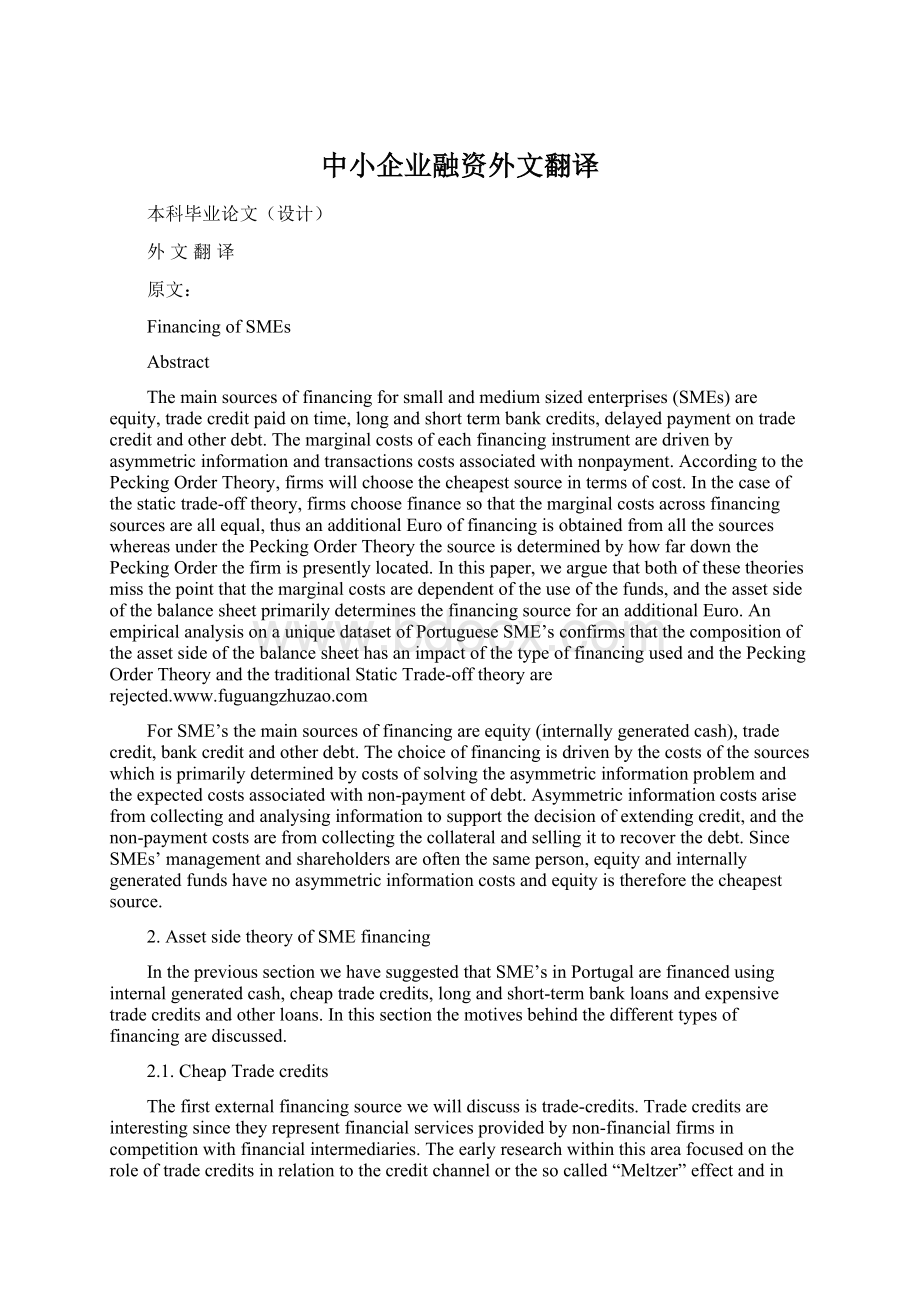中小企业融资外文翻译.docx
《中小企业融资外文翻译.docx》由会员分享,可在线阅读,更多相关《中小企业融资外文翻译.docx(7页珍藏版)》请在冰豆网上搜索。

中小企业融资外文翻译
本科毕业论文(设计)
外文翻译
原文:
FinancingofSMEs
Abstract
Themainsourcesoffinancingforsmallandmediumsizedenterprises(SMEs)areequity,tradecreditpaidontime,longandshorttermbankcredits,delayedpaymentontradecreditandotherdebt.Themarginalcostsofeachfinancinginstrumentaredrivenbyasymmetricinformationandtransactionscostsassociatedwithnonpayment.AccordingtothePeckingOrderTheory,firmswillchoosethecheapestsourceintermsofcost.Inthecaseofthestatictrade-offtheory,firmschoosefinancesothatthemarginalcostsacrossfinancingsourcesareallequal,thusanadditionalEurooffinancingisobtainedfromallthesourceswhereasunderthePeckingOrderTheorythesourceisdeterminedbyhowfardownthePeckingOrderthefirmispresentlylocated.Inthispaper,wearguethatbothofthesetheoriesmissthepointthatthemarginalcostsaredependentoftheuseofthefunds,andtheassetsideofthebalancesheetprimarilydeterminesthefinancingsourceforanadditionalEuro.AnempiricalanalysisonauniquedatasetofPortugueseSME’sconfirmsthatthecompositionoftheassetsideofthebalancesheethasanimpactofthetypeoffinancingusedandthePeckingOrderTheoryandthetraditionalStaticTrade-offtheoryare
ForSME’sthemainsourcesoffinancingareequity(internallygeneratedcash),tradecredit,bankcreditandotherdebt.Thechoiceoffinancingisdrivenbythecostsofthesourceswhichisprimarilydeterminedbycostsofsolvingtheasymmetricinformationproblemandtheexpectedcostsassociatedwithnon-paymentofdebt.Asymmetricinformationcostsarisefromcollectingandanalysinginformationtosupportthedecisionofextendingcredit,andthenon-paymentcostsarefromcollectingthecollateralandsellingittorecoverthedebt.SinceSMEs’managementandshareholdersareoftenthesameperson,equityandinternallygeneratedfundshavenoasymmetricinformationcostsandequityisthereforethecheapestsource.
2.AssetsidetheoryofSMEfinancing
IntheprevioussectionwehavesuggestedthatSME’sinPortugalarefinancedusinginternalgeneratedcash,cheaptradecredits,longandshort-termbankloansandexpensivetradecreditsandotherloans.Inthissectionthemotivesbehindthedifferenttypesoffinancingarediscussed.
2.1.CheapTradecredits
Thefirstexternalfinancingsourcewewilldiscussistrade-credits.Tradecreditsareinterestingsincetheyrepresentfinancialservicesprovidedbynon-financialfirmsincompetitionwithfinancialintermediaries.Theearlyresearchwithinthisareafocusedontheroleoftradecreditsinrelationtothecreditchannelorthesocalled“Meltzer”effectandinrelationtotheefficiencyofmonetarypolicy.Thebasicideaisthatfirmswithdirectaccesstofinancialmarkets,ingenerallargewellknownfirms,issuetradecreditstosmallfinanciallyconstrainedfirms.Themorerecentresearchbreakstheroleoftradecreditsintoastrategicmotiveandfinancialmotiveforissuingandusingthesecredits.
Strategicmotives
Thefirsttheorycentersonasymmetricinformationregardingthefirm’sproducts.Tradecreditsareofferedtothebuyerssothatthebuyercanverifythequantityandqualitybeforesubmittingpayments.Byofferingtradefinancethesuppliersignalstothebuyersthattheyofferproductsofgoodquality.Sincesmallfirms,ingeneral,havenoreputationthenthesefirmsareforcedtousetradecreditstosignalthequalityoftheirproducts.Theuseoftradecreditsisthereforedrivenbyasymmetricinformationoftheproductsandisthereforemorelikelytobeusedbysmallfirms,ifthebuyerhaslittleinformationaboutthesupplier,ortheproductsarecomplicatedanditisdifficulttoassestheirquality.
Thesecondstrategicmotiveispricing.Offeringtradefinanceonfavorabletermsisthesameasapricereductionforthegoods.Thusfirmscanusetradecreditstopromotesaleswithoutofficiallyreducingpricesorusethemasatoolforpricediscriminationbetweendifferentbuyers.Tradecreditsaremostadvantageoustoriskyborrowerssincetheircostsofalternativefinancingarehigherthanforborrowerswithgoodcreditratings.Thustradecreditscanbeusedastoolfordirectpricediscriminationbutalsoasanindirecttool(ifallbuyersareofferedthesameterms)infavorofborrowerswithalowcreditstanding.
Tradecreditsarealsousedtodeveloplongtermrelationshipsbetweenthesupplierandthebuyers.Thisoftenmanifestsitselfbythesupplierextendingthecreditperiodincasethebuyerhastemporaryfinancialdifficulties.Comparedtofinancialinstitutionssuppliershavebetterknowledgeoftheindustryandarethereforebetterabletojudgewhetherthefirmhastemporaryproblemsortheproblemsareofamorepermanentnature.
Thelastmotiveinnotstrictlyastrategicmotivebutisbasedontransactionscosts.Tradecreditsareanefficientwayofperformingthetransactionssinceitispossibletoseparatebetweendeliveryandpayment.Inbasictermsthetruckdriverdeliveringthegoodsdoesnothavetorunaroundtofindthepersonresponsibleforpayingthebills.Thebuyeralsosavestransactionscostsbyreducingtheamountofcashrequiredon“hand”.
Financingmotives
Thebasisforthisviewisthatfirmscompetewithfinancialinstitutionsinofferingcredittootherfirms.Thetraditionalviewoffinancialinstitutionsisthattheyextendcredittofirmswhereasymmetricinformationisamajorproblem.Financialinstitutionshaveadvantagesincollectingandanalyzinginformationfrom,inparticular,smallerandmediumsizedfirmsthatsufferfromproblemsofasymmetricinformation.Thekeytothisadvantageoverfinancialmarketsliesinthecloserelationshipbetweenthebankandthefirmandinthepaymentfunction.Thefinancialinstitutionisabletomonitorthecashinflowandoutflowsofthefirmbymonitoringtheaccountsofthefirm.
Butwithtradecreditsnon-financialfirmsarecompetingwithfinancialinstitutionsinsolvingtheseproblemsandextendingcredit.Howcannon-financialinstitutionscompeteinthismarket?
PetersenandRajan[1997]brieflydiscussesseveralwaysthatsuppliersmayhaveadvantagesoverfinancialinstitutions.Thesupplierhasacloseworkingassociationwiththeborrowerandmorefrequentlyvisitsthepremisesthanafinancialinstitutiondoes.Thesizeandtimingofthelendersorderswiththesupplierprovidesinformationabouttheconditionsoftheborrowersbusiness.Noticethatthisinformationisavailabletothesupplierbeforeitisavailabletothefinancialinstitutionsincethefinancialinstitutionhastowaitforthecashflowassociatedwiththeorders.Theuseofearlypaymentdiscountsprovidesthesupplierwithanindicationofproblemswithcreditworthinessinthefirm.Againthesupplierobtainstheinformationbeforethefinancialinstitutiondoes.Thusthesuppliermaybeabletoobtaininformationaboutthecreditworthinessfasterandcheaperthanthefinancialinstitution.
Thesuppliermayalsohaveadvantagesincollectingpayments.Ifthesupplierhasatleastalocalmonopolyforthegoodsthentheabilitytowithholdfuturedeliveriesisapowerfulincentiveforthefirmtopay.Thisisaparticularpowerfulthreatiftheborroweronlyaccountsforasmallfractionofthesuppliersbusiness.Incaseofdefaultsthesuppliercanseizethegoodsandingeneralhasabetteruseforthemthanafinancialintermediarysizingthesamegoods.Throughitssalesnetworkthesuppliercansellthereclaimedgoodsfasterandatahigherpricethanwhatisavailabletoafinancialintermediary.Theseadvantages,ofcourse,dependonthedurabilityofthegoodsandhowmuchtheborrowerhastransformedthem.
Ifasymmetricinformationisoneofthedrivingforcestheexplanationoftradecreditsthenfirmscanusethefactthattheirsuppliershaveissuedthemcreditsinordertoobtainadditionalcreditfromthebanks.Thebanksareawarethatthesupplierhasbetterinformationthusthebankcanusetradecreditsassignalofthecreditworthinessofthefirm.
Thattradecreditsareingeneralsecuredbythegoodsdeliveredalsoputsalimitontheamountoftradecreditsthefirmcanobtain,thusthefirmcannotusetradecreditstofinancetheentireoperationsofthefirm.
Insummarythepredictionisthatthelevelofasymmetricinformationisrelativelylowbetweentheprovidersoftradecreditandtheborrowersduetotheissuer’sgeneralknowledgeofthefirmandtheindustry.IntheempiricalworkbelowthevariablesexplainingtheuseoftradecreditarecreditriskfactorsandCostofGoodsSold.Sincethesetradecreditsaresecuredbythematerialsdeliveredtothefirm,firmscannot“borrow”formorethanthedeliveryvalueofthegoodsandservices.
2.2Bankloans
Bankshavelessinformationthanprovidersoftradecreditandthecostsofgatheringinformationarealsohigherforbanksthanforprovidersoftradecredit.Providersoftradecreditsalsohaveanadvantageoverbanksinsellingthecollateraltheyhavethemselvesdelivered,butduetotheirsizeandnumberoftransactionsbankshaveanadvantageinsellinggeneralcollateralsuchasbuildings,machineryetc.Banksthereforeprefertoissueloansusingtangibleassetsascollateral,alsoduetoasymmetricinformation,theyarelesslikelytoissueloanstomoreopaquefirmssuchassmallandhighgrowthfirms.Banksarethereforewillingtolendlongtermprovidedthattangibleassetsareavailableforcollateral.Intheempiricalworkbelowtangibleassetsandcreditriskvariablesareexpectedtoexplaintheuseoflong-termbankloansandtheamountoflong-termbankloansareli